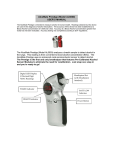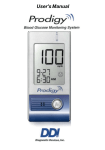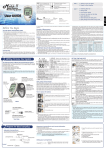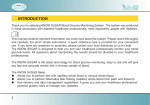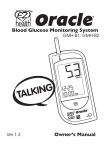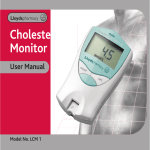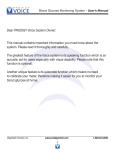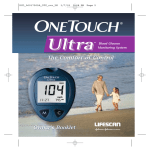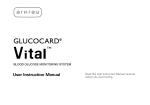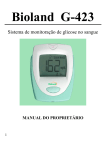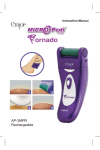Download User`s Manual - PDF file.
Transcript
Dear Q.STEPS™ System User:
Congratulations! You have selected a very reliable and accurate blood cholesterol and glucose advanced dual monitoring
system.
The system is easy to use and will provide you with the test results you need in just two simple steps.
You will
find everything you need to know about this system in this manual. Our Customer Service Department will also be happy to
help if you have any further questions.
Blood cholesterol monitoring will play an important role for you in preventing cardiovascular disease. Using the results from
our Q.STEPS™ System can help you manage your cardiovascular assessment program. In addition, blood glucose monitoring
plays a crucial role in controlling your diabetes. Using the results from our Q.STEPS™ System can help you and your
healthcare professional manage your diabetes.
Please feel free to call our toll-free number at 1-866-526-2873 to speak to our Customer Representatives if you have any
questions.
Thank you for selecting the Q.STEPS™ Biometer G/C Advanced Dual Monitoring System.
IMPORTANT: Please carefully read this User’s manual before using the product to test your blood. Follow all the instructions,
practicing the tests and performing all the quality control checks. In addition, talk with your diabetes healthcare professional.
These suggestions apply to all blood glucose and cholesterol monitoring systems. The American Association of Diabetes
Educators, the American
Table of Contents
Introduction
Features
Parts
General Warnings and Safety
Before you Start
Using your Monitor
Reading your Results
Maintenance and Cautions
Test Strip Information
Specifications
Calibration for Q.G/C ADMS
Troubleshooting
Frequently asked Questions
Further Information
Clinical Information
Lancet Manufacturer Contact Information
Warranty
Introduction
Thank you for purchasing the Q.STEPS™ G/C Advanced Dual Monitoring System (Model Q.G/C
ADMS). You have selected a reliable and medically approved monitor that is easy to use. In just two
simple steps the Q.G/C ADMS will provide you with the test results you need.
Two thirds of people in most countries have high cholesterol. Cholesterol is a type of fat that is
found in the body and is vital in helping us keep healthy. However, elevated levels of cholesterol are
a major risk factor for Coronary Heart Disease (CHD), Cardiovascular Disease and stroke. There
are two main types of cholesterol: good (HDL) and bad (LDL) cholesterol. This test measures total
cholesterol (both good and bad). You will find everything you need to know about this product in this
user’s manual.
Before using this system, please read the instructions included in this user’s manual carefully. Q.G/
C ADMS is an in vitro diagnostic device for self testing. This means that the system should only be
used for testing outside of the human body. High total blood cholesterol has been established as
one of the key factors associated with the occurrence of CHD. Lower blood levels of cholesterol are
linked with a decreased incidence of CHD.
Blood glucose monitoring also plays a crucial role in controlling your diabetes. Using the results from
our Q.G/C ADMS can help you and your healthcare professional manage your diabetes.
Features
Q.G/C ADMS is designed for home users to measure the amount of Cholesterol/Glucose (CHO/
GLU) in whole blood. When blood is applied to the test strip, a current is formed, and the magnitude
of the current produced is proportional to the concentration of CHO/GLU.
The Q.G/C ADMS is intended for use with fresh whole blood samples. The Q.G/C ADMS will not
Some people with very high hematocrit levels can obtain falsely decreased test results. Hematocrit
is the percentage of blood volume that is occupied by red blood cells.
The package contains:
Digital G/C Monitor See the diagrams on page 8 showing all the parts of the Digital G/C
Monitor.
User’s Manual An illustrated booklet describing the product and its operations.
Quick Start Guide This lists the basic operation steps for easy reference.
Storage Case A handy case for storing the Digital G/C Monitor, there is also a
section for storing the test strips and lancet devices.
Features
Parts description
Set Button This button is used to switch from one mode to another. For example,
you can press this button to recall past test results. See “Recalling Test Results”, page 16.
Beeper The Monitor will “Beep” as an alert.
Battery Compartment This compartment holds 2x AAA batteries (not included). See page 10
on how to install them.
Test Strip Platform Insert the test strip here for blood testing, see “Finger Blood Testing
Procedure”, page 13.
on|off Button This button turns the Digital G/C Monitor on and off.
LCD Display This is where the message and test results are displayed.
General Warnings and Safety
Please carefully read and understand the following warnings and cautions to ensure the safe and
correct use of this device in order to prevent injuries.
This device should not be used by anybody under 18 years of age, unless directed by his or her
healthcare professional.
DO NOT make any significant changes to your medication program without consulting your
healthcare professional.
Cleaning the Q.G/C ADMS is essential for reliable test results (see page 19).
PLEASE NOTE:
• DO NOT use the test strips beyond the expiration date
• DO NOT use test strips that have been damaged in any way (e.g. bent or creased)
• Ensure that the silver contact bars are intact
• The test strips must be kept in the vial with the cap in place
• Keep the test strips in a cool, dry place between 10ºC to 30ºC (50ºF to 86ºF) and discard
any unused test strips 10 months after first opening the vial
• DO NOT freeze or expose the test strips to direct sunlight or heat
• Only use the Q.G/C test strips with the Q.G/C ADMS to obtain reliable results
Before you Start
Inserting/Replacing Batteries
Remove the cover on the back of the Monitor. Insert 2x AAA batteries (not included). Replace the
cover.
• Non-rechargeable batteries are not to be recharged
• Always remove exhausted batteries from the monitor
• The supply terminals are not to be short circuited
• Do not mix old and new batteries or different types of batteries
• Do not use rechargeable batteries
• Only batteries of the same or equivalent type as recommended are to be used
• Batteries must be handled with care under adult supervision
• If batteries leak and come into contact with skin or eyes, wash immediately with copious
amounts of water
Before you Start
Setting the Date and Time
1.Press and hold the on|off button for approx. 15 seconds until you see the “y09” (year) sign
flash on the display. Release the on|off button.
2.Press the set button to select the desired year. For instance, “y10” means 2010.
3.Press the on|off button to confirm the year, then the month. The month will flash on the
display. Repeat the procedure - pressing the set button to change and the on|off button to confirm
at each stage. Do this for the month, day, hour and minute in sequence.
4.There is one Beep after the minutes are confirmed. The Monitor will automatically return
to the “InS” display (InS = Insert Strip).
Before you Start
Setting the Calibration Code
Cholesterol
Our Q.G/C ADMS has the built-in codeless or one code only for cholesterol. There is no need to
reset its calibration code, it should always be set to “7”
Glucose
Our Q.G/C ADMS also has simplified the built-in code calibration for glucose using the following
steps:
•While the device is in its off state, hold the on|off button until the “Cod” symbol appears on
the LCD, then release your finger
•Press the set button until the correct code number (found on vial) is shown on the LCD
•Press on|off button to confirm this change, the meter will go back to “InS” with the correct
code number shown on right hand side of the LCD
•Press and hold the on|off button for approx. 20 seconds until the concentration sign
appears ("mg/dL" or "mmol/L"), then release the on|off button
•Press the set button to switch the unit of concentration, "mg/dL" or "mmol/L"
•Press the on|off to confirm the change, the beeper sound and the meter will automatically
return to the “InS” display
Using your Monitor
Finger Blood Testing Procedure
This method of home testing requires you to follow the instructions below in detail. If you have
difficulty obtaining a reading at first, do not worry, the more familiar you are with this method of
testing the more confident you will become.
•Select a clean, dry work surface
•Insert a cholesterol strip while the monitor is turned off, it will automatically turn the system
on
•The strip must be flat against the test strip platform with the letter “C” facing up and the
two green stripes visible
•The display will show “CHO” with an image of one blood drop
Wash your hands using warm and soapy water, then rinse thoroughly. Warm water is preferable
because it will stimulate blood flow to your fingers. It may also help to hang your arm down by your
side for 10-15 seconds prior to testing. Dry your hands thoroughly.
Using your Monitor
Using the conventional Lancet and Lancet Device
•Unscrew the cap of the Lancet Device
•Turn the ridged part of the cap to the desired penetration level, the higher the number, the
deeper the Lancet punctures the skin (the setting for most people is 3 - 5)
•Fit a new sterile Lancet into the Lancet Holder, pushing in the Lancet might cock the
Lancet Device so use caution
•Twist off the Lancet Protective Disk to expose the needle of the Lancet
•Save the Lancet Protective Disk; do not throw it away
•Screw the cap back onto the Lancet Device
•Pull out the sliding barrel from the bottom of the Lancet Device until it clicks (the device
may not click if pushing the Lancet into the device has already done so)
•Place the Lancet Device at the apex of finger (or side of finger by nail) and press the blue
button to prick
•When finished, remove the Lancet carefully, place the Lancet Protective Disk back on and
dispose of properly
Using your Monitor
Obtaining Results
Allow a large drop of blood to hang from your finger by gently squeezing it. Wipe the first drop
of blood away using a clean, dry tissue and squeeze a second large drop (about the size of a
peppercorn. Place the large hanging drop of blood on the semicircle, which is on
the left hand side of the strip (see figure below). Do not remove the test strip from the monitor when
you apply blood to it.
You must ensure that you hold the large drop of blood to the strip for at least 3-5 seconds on the
reaction area. Do not smear the blood on the test strip or touch the reaction area with your finger. If
the amount of blood is sufficient, the unit will beep and begin to countdown. Do not apply a second
drop of blood after the monitor starts to countdown as this may alter your result.
The cholesterol result will be shown in 30 seconds (see page 16 for how to recall your test results).
If an insufficient amount of blood has been applied, the countdown will not begin and you will have
to start the testing procedure again using a new test strip. Once you remove the test strip the unit
will automatically turn off.
Reading your Results
Recalling Test Results
1.With the Q.G/C ADMS off, press and hold the on|off button for approx. 5 seconds to enter
the memory mode. You will see “M” flash on the upper left hand side of the display, release the
button – “CHO” or “GLU” will appear on the screen.
2.Continue pressing the set button to view previous test results. Up to 99 readings can be
stored and viewed in the device.
3.To view other past test results, simply continue to press the set button while in the memory
mode.
4.Press the on|off button to return back to “InS” display.
Reading your Results
Cholesterol Readings
Condition Total CHO mg/dL Total CHO mmol/L Advice / Action
Desirable < 200 < 5.17 Re-test in 3 months
Borderline 200 - 240 5.17 - 6.18 Re-test in a week if concerned
Undesirable > 240 > 6.21 Contact your healthcare professional
Glucose Readings for Diabetics
Fasting 70 - 110 mg/dL (3.9 – 6.1 mmol/L) 60 - 130 mg/dL (3.33 - 7.2 mmol/L)
1 hour after meal < 160 mg/dL (8.8 mmol/L) < 180 mg/dL (10 mmol/L)
2 hours after meal N/A < 150 mg/dL (8.3 mmol /L)
Reading your Results
Total cholesterol is one element of determining your risk of developing heart disease and stroke.
A full risk assessment (available at selected drug stores) is recommended to assess multiple risk
factors in addition to this cholesterol test.
The Q.G/C ADMS requires at least 12 μL (microlitres) of whole blood for cholesterol testing. If an
insufficient amount of blood is used, the unit will not countdown. You are safe to continue applying
blood until the beeper sounds and the countdown begins.
•The Q.G/C ADMS displays results for cholesterol between 100 - 400 mg/dL
(2.6 - 10.3 mmol/L)
•Results above 400 mg/dL (10.3 mmol/L) are displayed as “Hi”
•Results below 100 mg/dL (2.6 mmol/L) are displayed as “Lo”
Maintenance and Cautions
•Clean the Q.G/C ADMS test strip platform with alcohol swabs (not included) to prevent
contamination
•Do not drop or throw the Q.G/C ADMS Device
•Do not expose the Q.G/C ADMS Device to extreme temperatures or humid conditions for
long periods of time
•Do not tamper or attempt to fix the Q.G/C ADMS Device
•Do not immerse the Q.G/C ADMS Device in water
•Store the Q.G/C ADMS Device in the storage case whenever possible
Test Strip Information
•Write the date on the vial of strips when opening for the first time
•Discard any unused strips 10 months after first opening the vial
•Always keep the test strips stored inside the original vial
•Always ensure the cap is firmly secured back on the vial after removing your test strips
•Store the test strips at a temperature between 10ºC and 30ºC (50ºF and 86ºF)
•Avoid direct exposure to sunlight
•Test strips are usable up to the expiration date if they have not been opened
•Do not use test strips beyond their expiration date
•Do not use test strips that have been altered or damaged in any way
•Do not use test strips more than once
•Do not touch the reaction area when handling the test strips
Specifications
Q.G/C ADMS Performance Characteristics
Operating Temperature 18ºC to 30ºC (64ºF to 80ºF)
Operating Humidity 20% - 80% relative humidity (non-condensing)
Power Supply 2 x AAA alkaline batteries (not included)
Automatic Shut-Off After two minutes
Dimensions 107mm (length) x 64mm (width) x 28mm (height) approx.
Weight Approx. 57g
Measurement Range CHO: 100 mg/dl - 400 mg/dl (2.6 - 10.3 mmol/L)
Measurement Time CHO: 30 sec, GLU: 15 seconds
Memory Capacity Total of 99 readings
Specifications
Test Strip Performance Characteristics
Calibration for Q.G/C ADMS
This Q.G/C ADMS has been calibrated during production. If you need to check it, please use
Q.STEPS™ Control Solution, which is used to check the Q.G/C ADMS.
After obtaining the Control Solution, simply follow the same procedure as the “Finger Blood Testing
Procedure” but use the Control Solution instead of a blood sample.
Storage Conditions 10ºC to 30ºC (50ºF to 86ºF), store in capped test strip vial
Operating Temperature 18ºC to 30ºC (64ºF to 86ºF)
Operating Humidity 20% - 80% relative humidity(non-condensing)
Dimensions 49mm(length) x 10mm(width) approx.
Blood Source 12μL - 15μL whole blood for CHO, 2μL - 7μL for GLU
Blood Application On the left hand side of the sensor strip
Troubleshooting
Troubleshooting Errors Description of Error
If the Q.G/C ADMS is still reporting an error after checking all of the above, please contact us.
Frequently Asked Questions
The cholesterol-monitoring program should be conducted under the guidance of a healthcare
professional.
Q. How can I be sure that my test results are accurate?
A. Make sure that the code number on your test strip vial matches the code number
displayed on the Biometer. Make sure the Biometer LCD display shows whether the test is
for Glucose (GLU) or Cholesterol (CHO). For the cholesterol test, make sure that you have
used enough blood. A wet, round and shiny drop of blood should form over the semicircle
test spot and remain there during the countdown.
•Do not smear blood on the reaction area or apply more than one drop
•Do not touch the reaction area with your finger
•Do not use test strips more than once
•Do not use test strips that have expired
Q. What is cholesterol?
A. Cholesterol is a lipid (fat) and steroid naturally produced by your liver and is essential for the body
to function. When your cholesterol rises above the desirable level, it may build up in your body and
put you at an increased risk for heart disease or stroke. Cholesterol levels can be high due to diet,
lack of exercise or family history.
Frequently Asked Questions
Q. If I choose to repeat the test on the same day, what does it mean if my cholesterol level is
different?
A. Cholesterol levels can vary day to day within each person, so you should average your
results.
Q. From one cholesterol test result, is there a chance I may be placed in the wrong
cholesterol group – for example ‘slightly raised’ instead of ‘high’ risk?
A. Yes, especially if your result placed you on the border of two groups. Because cholesterol
does vary from day to day it is recommended that at least two results be averaged before
someone classifies themself.
Q. Will common foods, alcohol or medications affect my results?
A. Generally, no. Most substances will not interfere with the test, however, certain
medications e.g. Statins (cholesterol lowering medicines) will affect cholesterol levels.
Q. What can I do to make drawing blood easier?
A. Make sure your finger is warm and callous-free. Use the side of your fingertip – it is a less
sensitive area. Keep your hand below your heart before testing – let your arm hang down at your
side for 10-15 seconds.
Frequently Asked Questions
Q. Why is cholesterol important?
A. High cholesterol is one of the main risk factors for heart disease. Other risk factors of
heart disease include high blood pressure, smoking, being overweight and not exercising.
Q. What if my cholesterol reading is high?
A. If you have concerns about your result, it is best to contact your healthcare professional.
However, remember these important points:
•Any one cholesterol reading is never final because cholesterol can change from day to
day and in response to several factors, such as weight loss, illness or stress
•Cholesterol is a risk factor that can be controlled
•Many studies show that cholesterol is a risk factor that may be lowered by exercise and
diet
•Other risk factors that you can control include high blood pressure and smoking
Frequently Asked Questions
Any decisions about your risk factors for heart disease should not be made until you have consulted
with your healthcare provider.
If your cholesterol reading is high, you may like to test your HDL (High-Density Lipoprotein / Good
Cholesterol) or LDL (Low-Density Lipoprotein / Bad Cholesterol) Cholesterol levels. It is possible to
have a high “Total Cholesterol” reading but still have a low LDL Cholesterol reading.
Q. What can I do to ensure I will obtain an accurate reading with the Q.G/C ADMS?
A. Follow all of the directions in this manual carefully.
Q. Do I need to fast before I take the test or perform it at a specific time of day?
A. No, you can test yourself at any time, so fasting is not necessary. If you repeat the test, try
to do so under the same conditions.
Frequently Asked Questions
Q. How do I know if my cholesterol is too high or normal?
A. The National Cholesterol Education Program (NCEP) has established guidelines to
identify risk groups in adults associated with various cholesterol levels in blood. However, you
should discuss cholesterol results with your healthcare professional.
Classification for Total Cholesterol
1. “Current status of Blood Cholesterol Measurement in Clinical Laboratories in the United States: A
report from Laboratory standardization Panel of the National Cholesterol; Education Program.”
Clinical chem. 34/1, 1998, 193-201.
2. “Recommendations for Improving Cholesterol Measurement: A report from the Laboratory
standardization panel of the National Cholesterol Education Program.” NIH publication NO.
90-2964, Feb. 1990
Condition mg/dL mmol/L
Desirable < 200 < 5.17
Borderline 200 - 240 5.17- 6.18
Undesirable > 240 > 6.21
Page 54 of 44637
27
Frequently Asked Questions
Q. Why test my blood glucose?
A. It is important to keep your diabetes under control. Our monitoring system can help you do
this by providing you with accurate readings of your blood glucose levels. The results can also
help you see how other factors such as diet, exercise and medication can affect your diabetes.
your diabetes changes.
Q. How often should I check my blood glucose?
A. You and your healthcare professional should decide this according to your personal case.
Your age, diet condition, physical condition and type of diabetes are some factors important in
determining how often you should test your blood glucose levels.
Frequently Asked Questions
Q. What should I do if my test results are consistently high?
A. You want to keep your blood glucose or cholesterol levels near normal levels determined
by you and your healthcare professional. Contact your healthcare professional if your test results
show consistently high levels.
Q. What are the acceptable values for blood glucose if my diabetes is under control?
should consult with their healthcare professional to see what range they fall under.
ranges provided are for the general population of Diabetics, however, every person varies and
Blood glucose values change very rapidly over time. Self-tests are usually done before meals and/or
at bedtime. Ask your healthcare professional to set a suitable testing regimen that is appropriate for
you.
fasting is about 2 - 5 mg/dL (0.1 - 0.3 mmol/L). After meals, venous blood glucose is less than
results from the Q.STEPS™ system (finger blood) may be different from the laboratory results.
capillary blood value by approximately 10 - 50 mg/dL (0.55 - 2.78 mmol/L). T
1. Krall, LP and Beaser, RS: Joslin Diabetes Manual. Lea and Febiger. (1989) 138.
2. Skyler JS et al: Postgraduate Medicine (1987)81(6):163-174
3. Skyler JS, et al: Diabetes Cae (1981) 4:311-318
4. Caraway, WT: cArbohydrates, in Tietz NW (ed). Fundamentals of Clinical Chemistry. Philadelphia,
WB
Saunders Company (1976) 242-244
Further Information
For further information concerning advice on cholesterol and its affects, you can visit or contact us at
any of the following:
www.americanscreeningcorp.com
1 (866) 526-2873
Clinical Information
•The Q.STEPS G/C ADMS is not designed to monitor newborn whole blood samples
•The Q.STEPS G/C ADMS is intended for use with fresh whole blood (capillary, venous)
samples
•The Biometer will not give accurate results for plasma or serum samples
•Very high hematocrits may falsely decrease test results
•Very low hematocrits may falsely increase test results
•Reducing compounds, such as ascorbic acid, do not significantly affect blood glucose
results when occurring in normal blood concentrations, however, abnormally high concentrations of
such compounds may falsely decrease test results
•Too much water loss or dehydration may decrease glucose test results; symptoms for
severe dehydration include the following:
-Vomiting and diarrhea
-Drugs such as diuretics
-No “thirst” sensations
-Uncontrolled diabetes over a long period of time
-Shock
Warranty
This product is guaranteed for a period of one year from the date of purchase against mechanical
and electrical manufacturing defects in the U.S.A and Europe. There are no user serviceable parts
inside the instrument.
If the monitor becomes inoperative during this time, American Screening Corporation will replace the monitor with the
equivalent equipment at their option. Any attempt to repair by unauthorized persons invalidates the warranty. This does
not affect your statutory rights.
The warranty policy only applies when the Q.G/C ADMS is used with the Q.G/C ADMS test strips.
American Screening Corporation
7607 Fern Ave.
Shreveport, LA
71105
1 (866) 526-2873
www.americanscreeningcorp.com
Q.STEPS™ G/C ADMS































